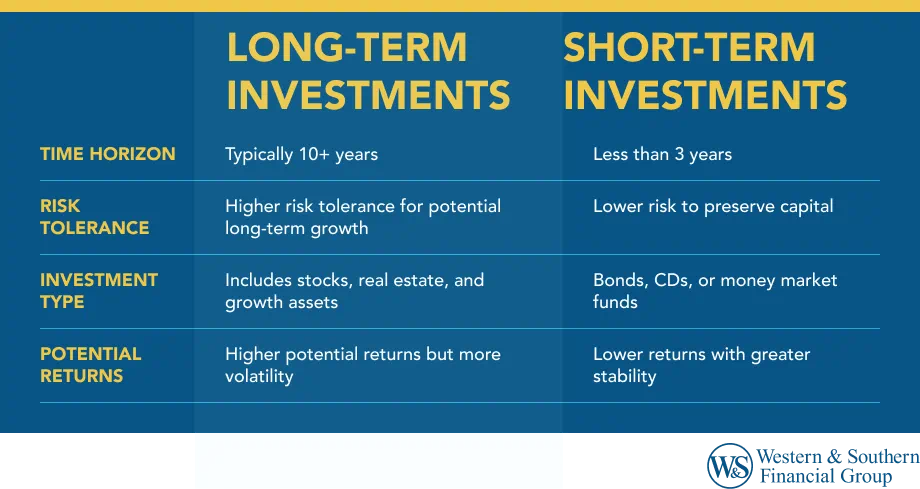

Table of Contents
- What Is Long-Term Investing?
- What Is Short-Term Investing?
- Differences Between Long-Term & Short-Term Investing
- Planning Long-Term & Short-Term Investment Strategies
- Who Might Consider Long-Term Investment Strategies?
- Who Might Consider Short-Term Investment Strategies?
- Considerations for Forming Investment Strategies
- Preparing to Move Forward With an Investment Strategy
Key Takeaways
- The main difference between long-term and short-term investors is their time horizon.
- Long-term investors generally have time horizons of 10+ years, while short-term investors focus on less than 3 years.
- Long-term goals like retirement or college savings require more complex strategies compared to short-term goals like vacations or home renovations.
- Factors like risk tolerance, desired returns, and using a financial advisor are key considerations for investment strategies.
- Long-term investors may tolerate more risk, while short-term investors often prefer lower-risk options like bonds to preserve capital.
Understanding the difference between long-term and short-term investing may help investors build their investing strategies. Developing this knowledge can be the first step in identifying the investment securities that are suitable for your goals.
Another important aspect of investment success is to make sure that your short-term investment strategies complement your long-term investment strategies. Before choosing your investments, it's important to identify the fundamental considerations that go into your investment strategy, such as your investment timeline and your tolerance for risk. Once you've done so, you can form long-term and short-term investment strategies that complement each other and get you closer to your goals.
What Is Long-Term Investing?
Long-term investments are bought and held for multiple years, such as 10 years or more. This investing strategy may be suitable for long-term financial goals, such as retirement and college savings, and can include certain stocks and mutual funds.
When an investor has several years or more until they plan to begin making withdrawals from their investment accounts, they might see themselves as being in a position to take on more risk than if they had only a few years to invest. This is because the longer periods of time could allow the investments to potentially recover from periodic declines in value. Of course, such a recovery is not guaranteed; any investment can gain or lose value over time, including the possible loss of the principal investment value.
What Is Short-Term Investing?
Short-term investments are typically bought and held for a shorter period of time — generally three years or less. They are typically suitable for needs or goals that are more immediate or in the near future — for example, saving for the purchase of a vehicle. If an investor chooses a short-term investing period, they might consider investment types that have relatively low market risk. However, seeking lower market risk does not guarantee gains or a sustained principal value.
Examples of short-term investment securities can include certificates of deposit (CDs), money market accounts, government bonds and Treasury bills.
Differences Between Long-Term & Short-Term Investing
Here are some of the differences between long-term investing and short-term investing:
- Time Horizon: The length of time before you begin taking withdrawals from your investment accounts defines your time horizon. Long-term is generally considered to be 10 years or more, while short-term is generally three years or less.
- Market Risk: Market risk is the possibility that assets exposed to the market may lose value. The level of market risk that's associated with an investment depends on the type of investment and your strategy. As you determine whether short- or long-term investments are right for you, consider discussing market risk with a financial professional.
- Investing Goals: Long-term investment goals typically take years or decades to reach and may include retirement and saving for college. Short-term investing goals may take months or a few years. Examples of short-term investing goals can include saving for a vacation, wedding or home improvement.
Planning Long-Term & Short-Term Investment Strategies
Long-term investment strategies can help support major purchases or life events that are several years or even decades away. Since long-term savings goals, such as retirement or college, often require large sums of money, it might help to plan your investment strategy as far in advance as possible.
Short-term investment strategies are typically designed for smaller goals that may be months or a few years away. Because of the shorter time frame, investment types that are appropriate for short-term goals are typically different than investment types used for long-term goals.
Even though they may have different time horizons and different associated tactics, long-term investment strategies and short-term investment strategies both can be formed in part by answering some of the same questions.
Here are some questions to explore before forming investment strategies:
- How much money will you need? To answer this question, you may need to make a few related assumptions. For example, if you're saving for retirement, you'll likely want to consider your life expectancy, desired retirement lifestyle and health care needs, among other factors.
- How will taxes factor into your investment strategy? Like inflation, taxes can have a large impact on your investment strategy. For example, you may want to consider accounts with specific tax features, such as 529 college savings plans, which offer tax-deferred growth of your investment.
- When will withdrawals begin? This is another way of asking how long your investing strategy will be. For example, if you're saving for your child's education, you could assume that withdrawals will begin in their first year of college.
- How long will withdrawals last? You might prefer to not end a long-term investment strategy with one lump sum withdrawal. For example, if you expect to retire at age 65 and assume a life expectancy of 85 years, you might want your withdrawals to last 20 years. However, for short-term goals, such as a vacation, you might withdraw one lump sum.
- Will you invest a lump sum or make recurring investments? When calculating the ultimate amount you can potentially reach by the end of your savings goal, you'll need to assume the frequency of payments or investment purchases. For example, will you invest a lump sum up front? Will you contribute a certain amount at the beginning of each year or will you invest a fixed amount every month?
- Which investment types will you use? The investment types you use may be chosen according to the rate of return you want and your tolerance for risk. The amount of time you have to invest also can help you determine the investment type to choose.
Who Might Consider Long-Term Investment Strategies?
Put simply, long-term investment strategies can be useful for anyone who has a savings goal that is at least several years away. In the world of personal finance, long-term goals are generally considered to be at least seven to 10 years away.
Long-term investment strategies might be considered by investors who want to:
- Save for Retirement: This is a common reason for a long-term investment strategy because, for many, retirement can be the largest financial goal of a lifetime, as well as the longest to reach.
- Save for College: Higher education is expensive, and the cost is rising. Long-term investment strategies can be an important means of paying for college.
- Build Wealth: Long-term investment strategies could help grow your money over time.
It's important to keep in mind that the typical long-term investment types are not appropriate for all investors. For example, stocks and stock mutual funds can potentially make useful long-term investments. However, the potentially higher relative performance of stock investments comes with greater market risk. Therefore, people with low tolerance for risk might consider other investment types to diversify their holdings with lower-risk investments.
Who Might Consider Short-Term Investment Strategies?
People investing for savings goals that are less than three years away may think about exploring short-term investment strategies.
Short-term investment strategies might be considered by people who are saving for:
- Vacations: You might prefer to plan that big trip you've always wanted by funding it with money you've invested, rather than putting it on a credit card and accruing debt, for example.
- Weddings: You may have anywhere from a few months to a few years to save for all of the expenses related to a wedding. The right short-term savings strategy can help make your big day the best it can be.
- Gifts: Whether it's for birthdays or major holidays, you may choose to keep money in an interest-bearing account for purchasing gifts for friends and family.
- Home Improvements: Rather than take money out of home equity, a short-term investing strategy may help you fund home improvement renovations or projects.
Long-term investments could be saving for retirement, while short-term investments could be saving for a wedding or vacation.
Considerations for Forming Investment Strategies
There are a number of general considerations to keep in mind when forming your investment strategies. These include timeline to invest, risk tolerance, risk capacity, desired rate of return, taxes, and whether you want to do it yourself or work with a financial professional.
Timeline to Invest
Your timeline to invest — the amount of time between now and the day you begin making withdrawals from your investment account — is one determining factor in choosing suitable investment types. Just like planning a trip, you want to choose the best vehicle to get you where you want to go. If you have a significant number of years to go before reaching retirement, you can consider yourself a long-term investor. If you have three years or less to invest, you can consider yourself a short-term investor. A four- to seven-year timeline is considered intermediate. Long-term investors may enjoy less risk due to the fact they have more time for their portfolios to make up for potential losses. Meanwhile, short-term investors may want to avoid volatile investments, such as some riskier stocks or stock mutual funds.
Risk Tolerance
Risk tolerance is the term for how much risk you are willing to take with your investments. Although long-term investors can afford to take more market risk, they might want to invest in a way that suits their personal tolerance for risk. For example, a portfolio of stocks can be suitable for a long-term investor with high risk tolerance. However, including certain bonds in the investment mix may be more suitable for a long-term investor with low to moderate risk tolerance.
Risk Capacity
The degree to which you can financially afford to see short-term declines in the value of your investment accounts determines your risk capacity. For example, investors who are fortunate enough to have surpassed their savings goals or who do not foresee ever needing to make withdrawals from their accounts can have high risk capacity. However, those who risk missing their savings goals due to a severe market downturn may have lower risk capacity.
Desired Rate of Return
There is a direct correlation between risk and reward with investing. Generally, the higher the return you are seeking, the more market risk you may need to accept to obtain that return. Some individual stocks are relatively high in market risk and have historically averaged higher returns than bonds, which are relatively low in market risk.1
Taxes
You might want to consider your income tax rate — or your desire to avoid or reduce taxes — when choosing your investment strategy and investment types. For example, if you want to minimize taxes and you are investing for retirement, you may choose a tax-deferred investment account, such as an individual retirement account or IRA. If you are a long-term investor and you have a taxable brokerage account, you may want to choose tax-efficient investments, such as index funds, ETFs exchange-traded funds (ETFs), or municipal bond funds. Keep in mind that each account type or investment product has its own unique features or requirements that you should fully understand before investing.
Do It Yourself or Hire a Financial Professional?
Each person's investment strategy will be unique to their individual goals and tolerance for risk. If you feel comfortable and knowledgeable about investments, you may be able to choose and implement your own investment strategies. But it can make sense to consider hiring an investment advisor or financial professional to recommend investment types and help guide you in choosing the right investment strategy to meet your personal needs.
Finally, keep in mind that planning for long-term savings goals could be more complex than short-term savings goals. If you're planning for long-term goals, such as retirement or your children’s higher education, it might be helpful to use a retirement calculator or college savings calculator .
Preparing to Move Forward With an Investment Strategy
Forming the right investment strategy for you will depend on several factors, such as your timeline to invest, tolerance for risk and desired rate of return. Once your investment objectives and risk tolerance are identified, the specifics of your investment strategy, such as the types of investments, can be determined.
Since investment objectives and strategies are unique to each individual, it may be helpful to seek the assistance of a financial professional who can provide you with personalized guidance to help form and implement your investment strategy.
All investing involves risk, including the possibility of a loss of the money invested.
Sources
- Investment portfolios: Asset allocation models. https://investor.vanguard.com/investor-resources-education/education/model-portfolio-allocation.


















